Introduction
I created an app concept that facilitates the exchange of books. Since they aren’t high-value enough, a lot of current marketplace offerings can’t be used. Initially, I was thinking about how book exchanges require you to meet 2 main criteria of
- it requires you to find someone with a book you want, and
- you must own a book that they want in return.
Background
-The Prelude-
In 2017, I started a project called Bangalore Book Hunt. It was a community-run initiative that dropped books off at metro stations and other public spots, in hopes that people would find, read, and hide them.
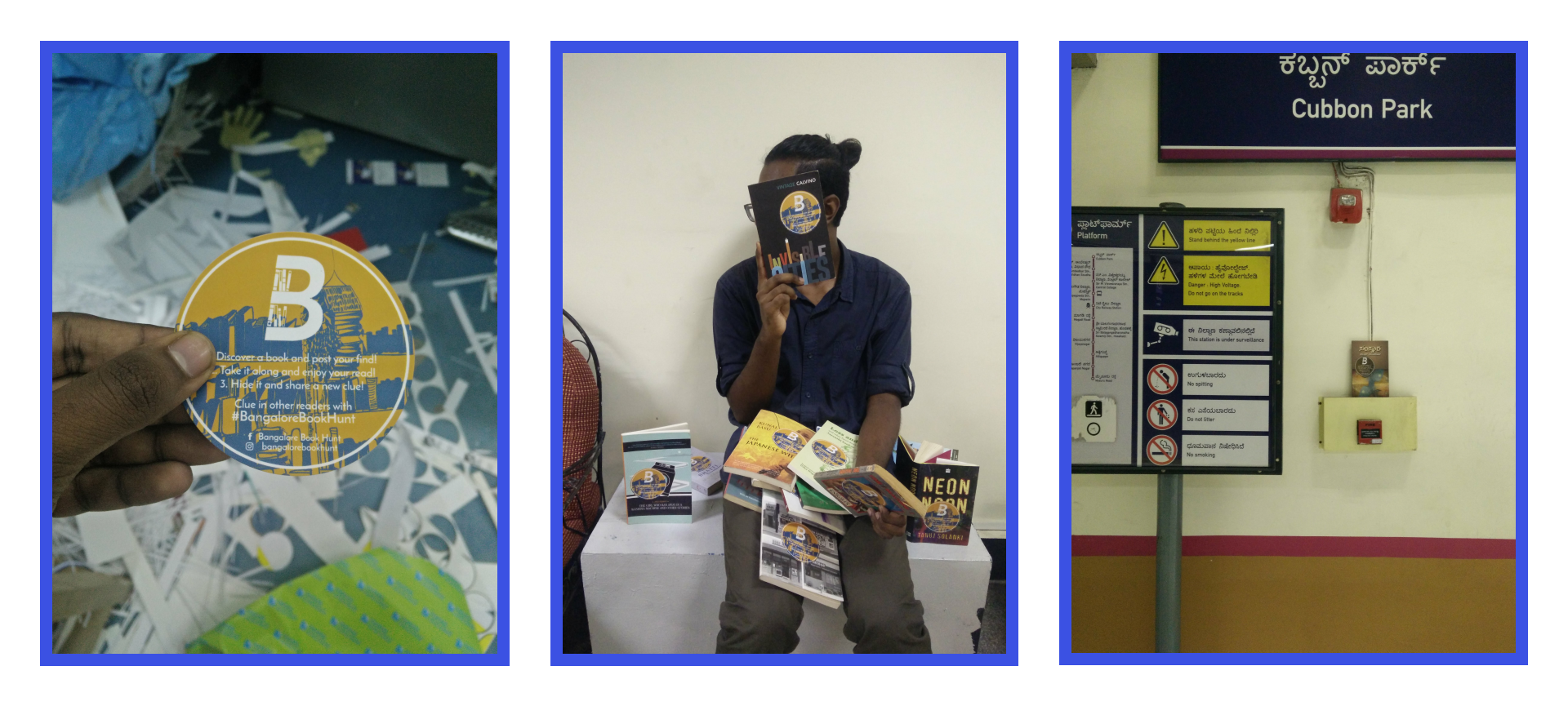
The project was a test of the honour system, and boy did we learn our lesson. We started out with around 70 books, all donations from kind individuals who believed in the project. After dropping 10 books off every week for the next 2 months, we were out of books. And the books we put out didn’t seem to be returning. We did expect to lose a few books, of course. But we didn’t account for that being the majority.
I decided to revisit the project recently to see where I went wrong, and what I’d do differently with what I’d learned. My goal was to explore the viability of an app that facilitates the circulation of books, and what it would take for it to succeed. That got me to my problem statement and my high-level goals.
These are some of the major challenges that impended the project earlier. They acted as a starting point that guided my exploratory research.
- System - it needed to be enforced somehow. While the project does require us to put our trust in people, there had to be some system of accountability.
- Incentive - people had a good reason to pick up the books, but no reason to return them. This time I needed to motivate people to stick to the rules.
Research
I started out by conducting informal interviews which were exploratory. They involved conversations around how books are purchased, the problems faced with marketplace apps, and thoughts on a marketplace dedicated to books only.
My focus was on doing Just Enough Research, so I wasn’t just designing based solely on my own assumptions. I chose people who were in my optimal target audience, and representative of different purchasing and second-hand shopping experiences.
I followed that up with secondary research to understand the following things:
- How do people safely use second-hand platforms
- What makes second-hand stores a good choice for their customers
- Why do people trust alternative online stores (like Instagram thrift stores)
I decided I could illustrate my idea better in the same interview if I presented a wireframe of it. This way I could check my basic information architecture and usability of the app. Ideally I would only start designing only after I had the entire context, but I wanted to optimise my time better. Design is iterative, afterall.
Here are some of the things I uncovered from the interviews.
Problems
- Nothing is as convenient as ordering from Amazon.
- Buying second hand isn’t cheap enough to justify the trouble.
- Bookstores enable browsing - you don’t know what you want, but you can find something based on what’s available. Can’t do that online as easily.
What is being done already?
- The most popular are second-hand bookstores (trust-worthy, good choice of books).
- Borrowing from friends (trust-worthy, no cost involved).
- Twitter book exchanges.
Initial Insights
- Safety was the first concern, and was a make or break for this app. Books weren’t of high enough value to justify the potential risk of dealing with strangers. The women I interviewed revealed they don’t feel safe using such platforms and tend to ignore them completely, and most men I know bring someone along while making such transactions.
- Convenience + Risk, vs. Cost was a crucial point that had an impact on how useful this would be to people.
- Discoverability was important to buyers - they liked to browse bookshelves and find new books to read. Sometimes they don’t mind finding particular books if they can find similar ones.
Problem Statement
-How Might We?-
I reframed my pain points to land up at my problem statement, my guiding light, which is:-
How might we facilitate the exchange of books between individuals, while keeping safety in mind, being logistically easy, and is sustainable.
Alternatively, how might we combine the trust of borrowing from a friend, the discoverability of browsing at a bookstore and finding books to read, with the ease of ordering from Amazon into one experience?
Pain Points
I took my insights and made sense of them in the context of problems I wanted to solve. After prioritizing this list, I had 4 pain points I decided to focus on.

- Online marketplaces are considered risky options. People want to know as much about whom they're talking to, while not sharing too much information about themselves.
- Buying new books is expensive, especially for voracious readers.
- Second-hand bookstores isn’t as convenient as ordering a book online.
- You can just look around a bookstore to find new books, but that experience isn't as satisfying online.
Assumptions
These decisions relate to creating a business model and ensuring it is sustainable. I made a few assumptions along the way so I could focus the scope of this project. Ideally I would discuss these with the relevant teams and see if there’s a way to validate these assumptions before execution. And if not, decide on how these assumptions would be measured after shipping.
- The whole system is based on the assumption that the users of this app value books equally. One book they like is equal to another book they like. This had mixed results when asked to the interviewees. But I chose to continue since the app doesn’t aim to provide the widest variety of high quality books. This was one of the limitations of such second-hand marketplaces.
- While completely optional, I built features that allow the use of services like this, or general post/courier services. My assumption is that if considerable trust was built, people would be comfortable sharing their address to use services like Dunzo.
Solution
-You know, the good stuff-
The end result is an app that I call Local Library. It’s a marketplace app that exclusively has books on it. Here’s how it solves the pain points I discovered earlier:-
1. How It Works
The app implements a token system - you get one token for giving a book, which can be used to get a book from someone else. This alleviates the need to find someone who both wants a book you have, and has a book you want.
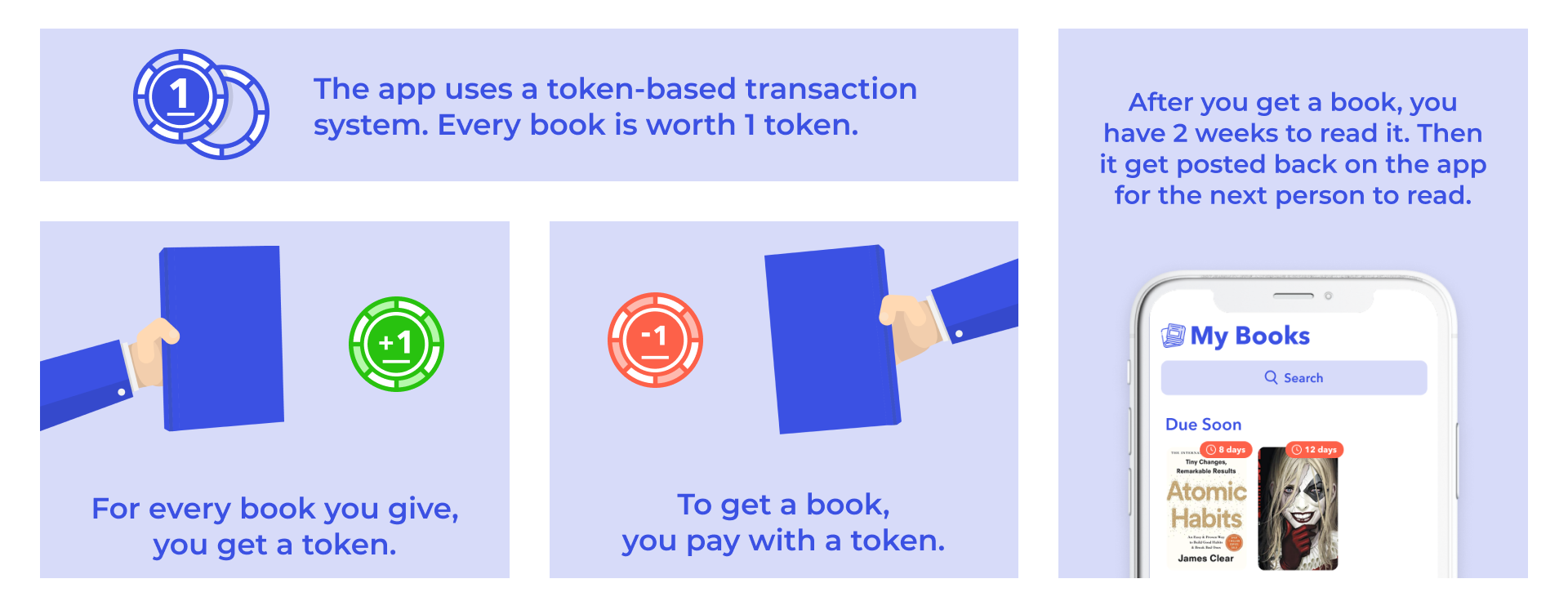
The app has two main screens that are built around the book exchange, the Explore and Requests pages. All the books available for you to take are on the Explore page. And the Requests page has all the books people are looking for. The token system ensures that people who are getting books through the app are also giving just as many books in return.

First time users - When people join the app, they won’t have any points. To help get them their first token, they are asked to post up 5 books of their own for people to get. They can also browse the Requests section for books they might have that other people are looking for.
2. Safety
Every user has a public user profile that shows their name, the location they’ve selected, their transactions through the app, and their book interests. This is accessible to other users when they begin a chat, so they feel better and safer about whom they’re talking to.
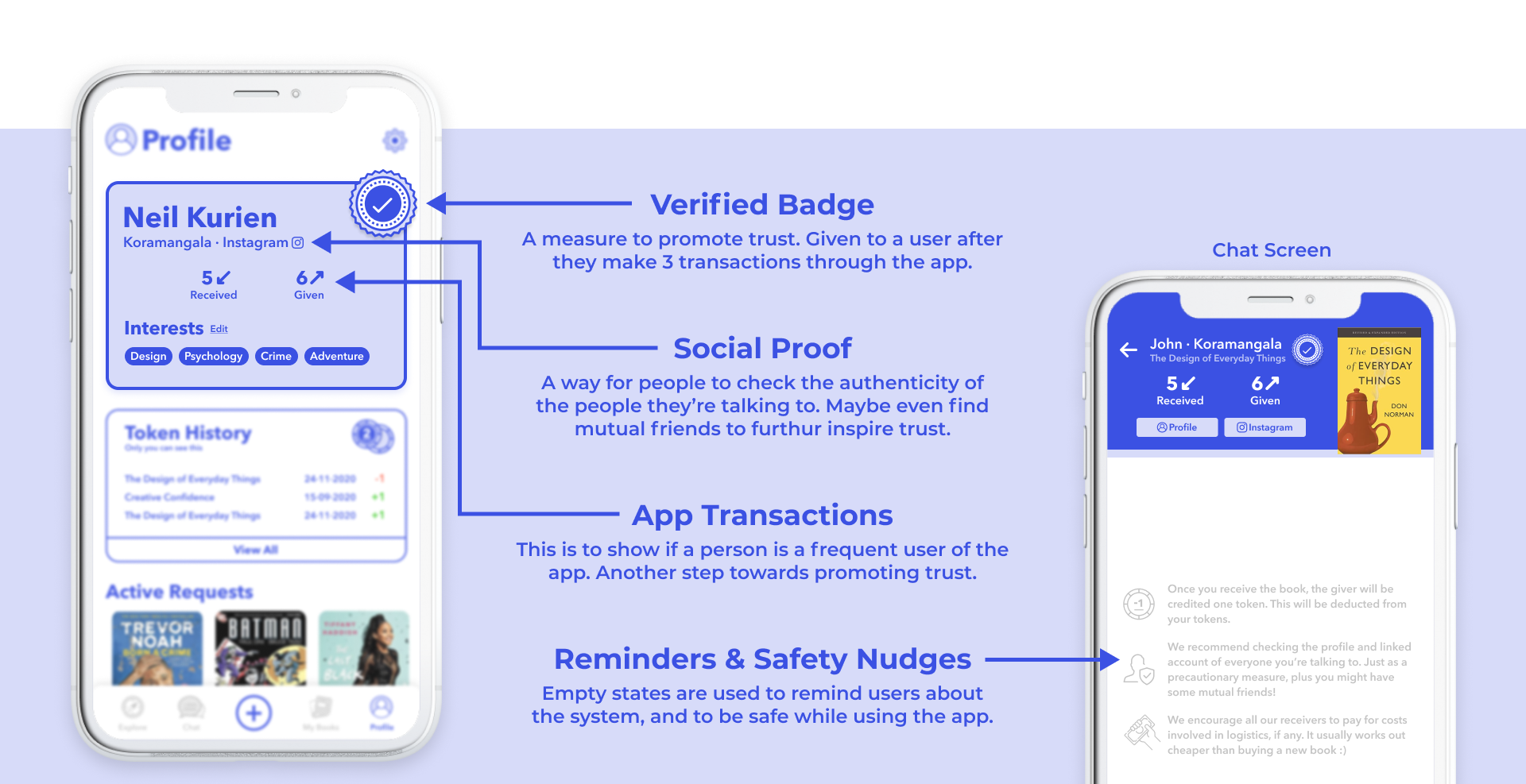
Bits of the profile card are also present on the chat screen, as an extension of the header bar. It shows how much the person has used the app to promote trust with users who’ve used the app multiple times. They are also given a verified badge as a social token of trust.
There is a social media link to check a user’s authenticity. As an added benefit, you can use many of social media’s inherited features to further establish trust, like finding mutual friends, etc.
A limitation of this system is that while the app aims to keep people on a first name basis and keep all personal information required to the bare minimum, linking their social media might seem counterintuitive. I decided not to make this feature mandatory, so people can choose to use it only if they are comfortable with it and the benefits it provides.
Rejected Idea - Adding a social aspect to the app. People can add each other as friends, and you can see if you have any mutual friends with the person you’re making the book exchange with.
I decided against this since it heavily relies on people adopting the friend system and doing the work of adding everyone they know to it. Since other social media apps already have all this functionality and also have market monopoly, I preferred to leverage that into my app, and focus on my primary goals.
Chatting with someone new was also an important part of the user journey to consider. Who is able to message whom, and how. Book requests shouldn’t just be a way for people to start a conversation. So the only way to start a conversation is to send a picture of the book first, and only after the person allows it will you be able to continue the conversation.
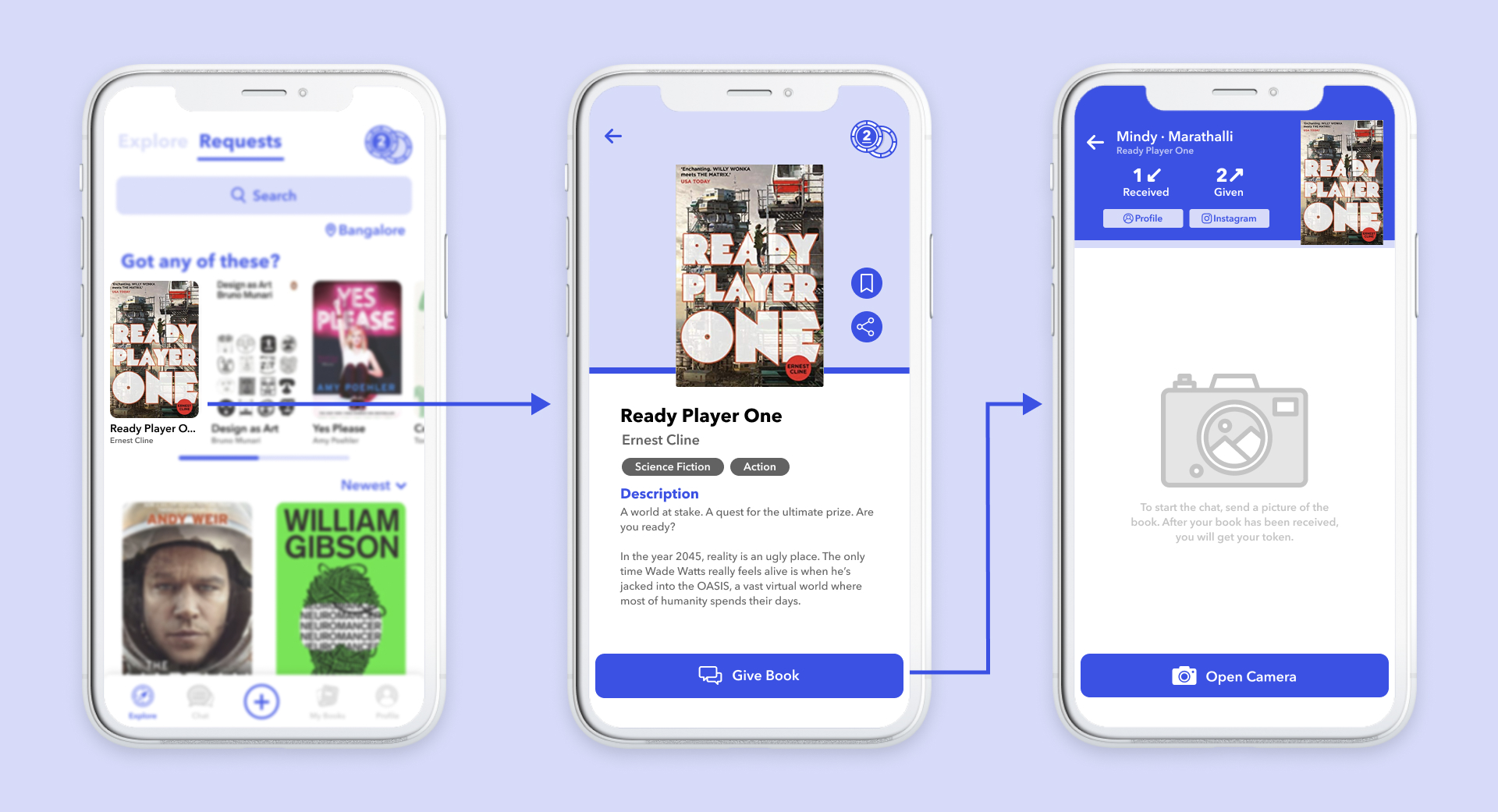
While designing a platform that lets you send pictures to a user first, I’m not naive enough to not know what to expect. In the words of Dinesh from Silicon Valley, “Uhh no, that one is not a hot dog”. Ideally there would be an algorithm that could filter out NSFW images, but the more feasible solution would be to make all the pictures blurry and let users report accounts.
3. Convenience
Most marketplace apps serve only to connect someone interested in selling something, with someone who’s looking to buy it. The ‘how’ of it is to be discussed over chat and that’s the extent of the app’s capabilities. Since the app doesn’t know the status of an offline exchange, I designed the status markers to keep people accountable.
Once you ‘Mark as Interested’ in a chat, the app deducts your token and keeps it in holding. And once you mark it as received, the other person receives the token. To make this feel more human and extend the possibilities through the app, the buttons have more humane copy like “Mark as On The Way”. This also allows people to use external services like Dunzo while the app handles accountability.

The factors that influence who a user decides to get a book from are the distance from their location, and the condition of the book. My assumption is that people prioritise the former more, so I designed that as the major differentiating factor between two people who’ve posted the same book. This is also quantifiable by the app, which lets it sort the listings accordingly.
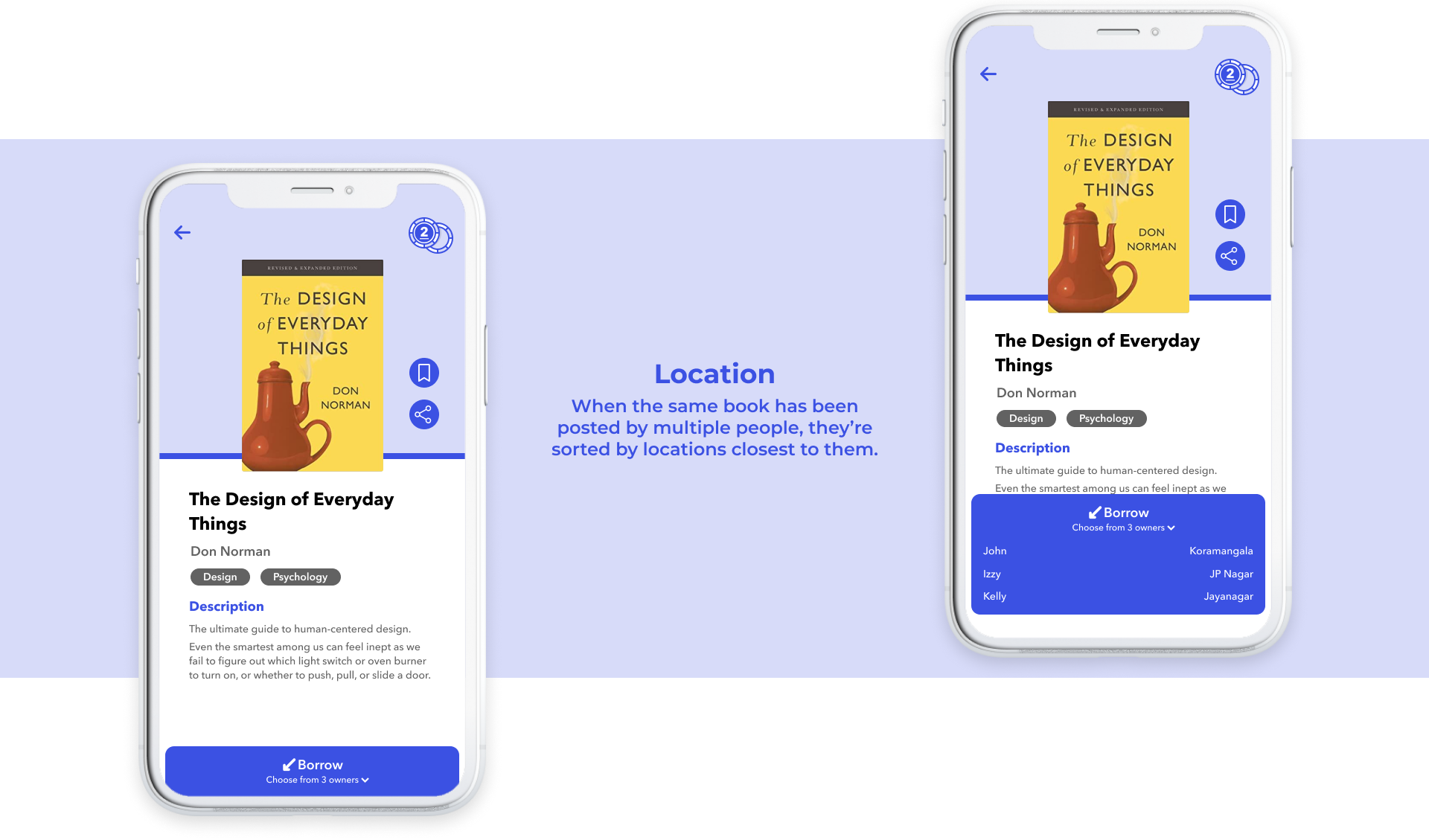
The My Books page acts as a hub for all the books from the app that are in your possession. It shows you when they’re due back, when it’s been reposted in the app, and the history of all your books. The status markers for each book are colour-coded and quickly let you know that status of each book.

4. Discoverability
With platforms that rely on users generating the content, the question of quality and variety comes up. With this app, I’m hoping the users find themselves less picky since the books don’t cost them as much. The potential lack of specific books should be offset by the variety and almost zero cost of getting a new book.
To make up for these gaps, I designed the experience to match users to books based on their interests. And make books scannable with genre tags, nudging them to discover new books in the same domain as their interest.
The recommended section let’s them know if a book in their Request or Wishlist collections are available, or recommends other books from the same genre as their interests.
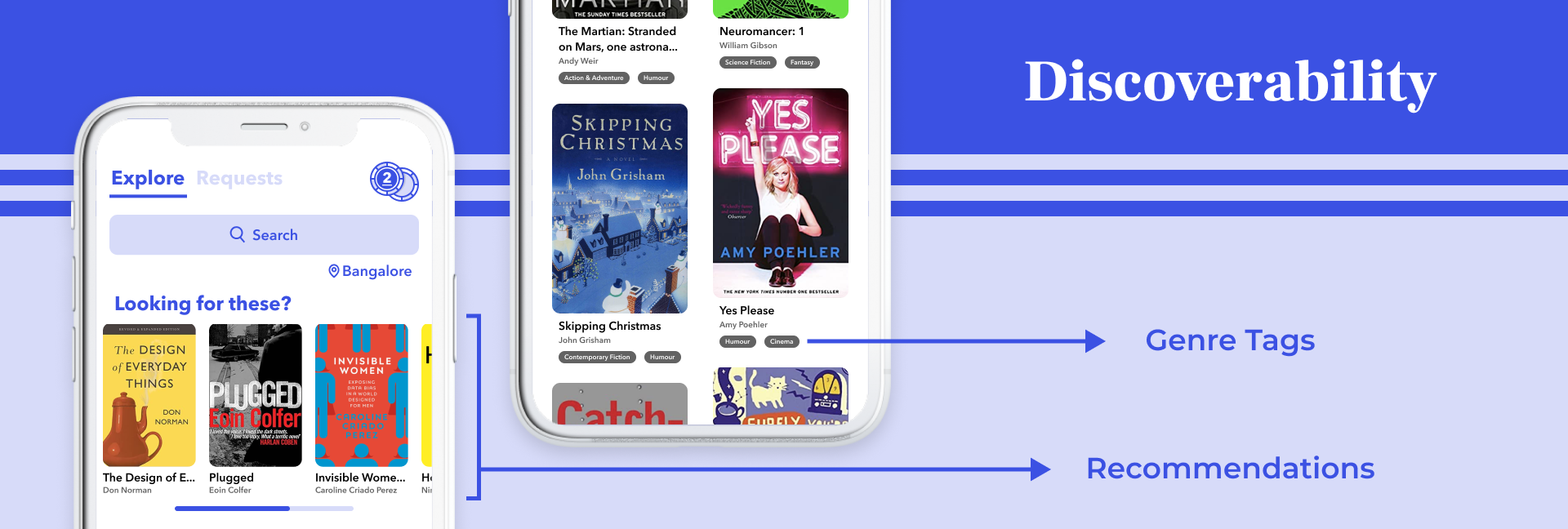
Learnings
- While conducting user interviews, I know I would've benefitted from a plan of action. They ended up being longer than I intended and times when I strayed from the topic. While I did understand the problem from a different perspective, in hindsight it's possible I introduced some bias by bringing up my own assumptions.
- I had to redesign parts of the app multiple times because I got new ideas while halfway through. As a fictional project, I wanted my best ideas to be included. But it turned into a never-ending project, so I planned out what my finished app would look like, and then worked my way there. On the bright side, you've always got to save some for v2.0!

